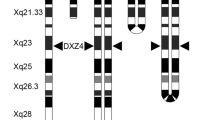Summary
Fifteen unrelated individuals were found among the patients of the Cytogenetics Laboratory who possessed multiple-satellited marker chrmosomes (14 with double satellites and 1 with triple satellites). Cytogenetic analysis was carried out by means of a conventional staining method and also by R, C, and Q banding and by the technique of silver staining. The intercalar structures of all 15 cases differed from the terminal satellites in their biochemical composition: they were resistant to heat denaturation, and stained heavily with the R-banding technique. Accordingly, they consisted of GC-rich material identical with that which in varying quantity is a regular constituent of the short arms of acrocentric chromosomes. The findings described indicate that any larger accumulation of such R band-positive material tends to dissociate from the basal segment of short arms by a proximal secondary constriction. We therefore assume that the formation of intercalar satellites may be interpreted as a cytological consequence of extreme natural R polymorphism.
Similar content being viewed by others
References
Archidiacono, N., Capoa, A. de, Ferraro, M., Pelliccia, F., Rocchi, A., Rocchi, M.: Nucleolus organizer andNN-band distribution in morphologic and fluorescence variants of human chromosomes. Hum. Genet. 37, 285–289 (1977)
Bauchinger, M., Schmid, E.: Ein Fall mit balancierter (14p+; 15p−) Translokation. Humangenetik 8, 312–320 (1970)
Bloom, S. E., Goodpasture, C.: An improved technique for selective silver staining of nucleolar organizer regions in human chromosomes. Hum. Genet. 34, 199–206 (1976)
Capoa, A. de, Ferraro, M., Menendez, F., Mostacci, C., Pelliccia, F., Rocchi, A.: Ag staining of the nucleolus organizer (NO) and its relationship to satellite association. Hum. Genet. 44, 71–77 (1978)
Caspersson, T., Zech, L., Johansson, C., Modest, E. J.: Identification of human chromosomes by DNA-binding fluoreszent agents. Chromosoma 30, 215–227 (1970)
Caspersson, T., Lomakka, G., Zech, L.: The 24 fluorescence patterns of human metaphase chromosome—distinguishing characters and variability. Hereditas 67, 89–102 (1971)
Comings, D. E.: Mechanisms of chrommosome banding and implications for chromosome structure. Annu. Rev. Genet. 12, 25–46 (1978)
Court-Brown, W. M., Jacobs, P., Brunton, M.: Chromosome studies on randomly chosen men and women. Lancet 1965 II, 561–562
Craig-Holmes, A. P., Moore, F. B., Shaw, M. W.: Polymorphism of human C-band heterochromatin. I. Frequency of variants. Am. J. Hum. Genet. 25, 181–192 (1973)
Evans, H. J., Buckland, R. A., Pardue, M. L.: Location of the genes coding for 18s and 28s ribosomal RNA in the human genome. Chromosoma 48, 405–426 (1974)
Gigliani, F., Capoa, A. de, Rocchi, A.: A marker chromosome number 14 with double satellite observed in two generations: An unbalanced chromosome constitution associated with normal phenotype. Humangenetik 15, 191–195 (1972)
Goodpasture, C., Bloom, S. E., Hsu, T. C., Arrighi, F. E.: Human nucleolus organizers: The satellites or the salks? Am. J. Hum. Genet. 28, 559–566 (1976)
Gosden, J. R., Mitchell, A. R., Buckland, R. A., Clayton, R. P., Evans, H. J.: The location of four human satellite DNAs on human chromosomes. Exp. Cell Res. 92, 148–158 (1975)
Gosden, J. R., Gosden, C., Lawrie, S. S., Mitchell, A. R.: The fate of DNA satellites I, II, III and ribosomal DNA in a familial dicentric chromosome 13;14. Hum. Genet. 41, 131–141 (1978)
Henderson, A. S., Atwood, K. C.: Satellite-association frequency and rDNA content of a double-satellited chromosome. Hum. Genet. 31, 113–115 (1976)
Henderson, A. S., Warburton, D., Atwood, K. C.: Location of ribosomal DNA in the human chromosome complement. Proc. Natl. Acad. Sci. USA 69, 3394–3398 (1972)
Holbek, S., Friedrich, U., Lauritsen, J. G., Therkelsen, A. J.: Marker chromosome in parents of spontaneous abortuses. Humangenetik 25, 61–64 (1974)
Kurnit, D. M.: Satellite DNA and heterochromatin variants: The case for unequal mitotic crossing over. Hum. Genet. 47, 169–186 (1979)
Lau, Y.-F., Wertelecki, W., Pfeiffer, R. A., Arrighi, F. E.: Cytological analyses of a 14p+ variant by means of N-banding and combinations of silver staining and chromosome bandings. Hum. Genet. 46, 75–82 (1979)
Martin, A. O., Miller, L., Simpson, J. L., Thomas, C., Rzeszotarski, M. S., Elias, S., Sarto, G. E., Patel, V. A.: Localization of the nucleolar organizer by computer-aided analysis of a variant no.21 in a human isolate. Hum. Genet. 48, 211–219 (1979)
Miller, D. A., Breg, W. R., Warburton, D., Dev, V. G., Miller, O. J.: Regulation of rRNA gene expression in a human familial 14p+ marker chromosome. Hum. Genet. 43, 289–297 (1978)
Rocchi, A., Capoa, A. de, Gigliani, F.: Double satellites: Autoradiographic study of a chromosomal marker observed in two generations. Humangenetik 14, 6–12 (1971)
Schnedl, W.: Structure and variability of human chromosomes analyzed by recent techniques. Hum. Genet. 41, 1–9 (1978)
Sehested, J.: A simple method for R banding of human chromosome, showing a pH-dependent connection between R and G bands. Humangenetik 21, 55–58 (1974)
Stoll, C., Rohmer, A., Korn, R., Heumann, G.: Familial 13p+ chromosome with mental retardation and dysmorphic features in two children. Hum. Genet. 34, 81–84 (1976)
Sumner, A. T.: A simple technique for demonstrating centromeric heterochromatin. Exp. Cell Res. 75, 304–306 (1972)
Verma, R. S., Lubs, H. A.: Inheritance of acridine orange R variants in human acrocentric chromosomes. Hum. Hered. 26, 315–318 (1976)
Verma, R. S., Dosik, H., Lubs, H. A.: Size variation of the short arm of human acrocentric chromosomes determined by R-banding by fluorescence using acridine orange (RFA). Hum. Genet. 38, 231–234 (1977)
Yoder, F. E., Bias, W. B., Borgaonkar, D. S., Bahr, G. F., Yoder, I. F., Yoder, O. C., Golomb, H. M.: Cytogenetic and linkage studies of a familial 15p+ variant. Am. J. Hum. Genet. 26, 535–548 (1974)
Author information
Authors and Affiliations
Rights and permissions
About this article
Cite this article
Balíĉek, P., Žižka, J. Intercalar satellites of human acrocentric chromosomes as a cytological manifestation of polymorphism in GC-rich material?. Hum Genet 54, 343–347 (1980). https://doi.org/10.1007/BF00291580
Received:
Issue Date:
DOI: https://doi.org/10.1007/BF00291580




